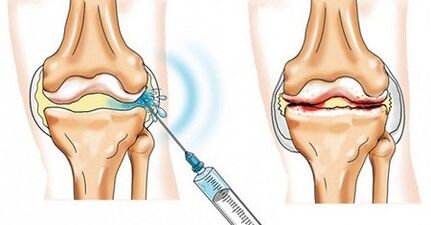
It will be an unpleasant disease of the musculoskeletal system as a knee joint arthrosis.From this article, you can find out the type of disease, why it occurs, what are the main symptoms of knee arthrosis and how to treat this dangerous disease.
Knee joint arthrosis (other names - gonartrosis) is a chronic disease of the knee joint, in which the articular destruction of cartilage joints, followed by a deformation of the joint motor activity and limits it, is called.
Gonarthrosis is the most common type of arthrosis.Often, the disease is diagnosed in people over 40.In older age groups, knee arthrosis is more common in women, in younger patients the disease is more often diagnosed in men.In about 7% of cases, the disease leads to the development of defects.
Cause
The main causes of disease development are:
- Violation of metabolism in the body;
- Excess weight, leading to increased load on the knee joint;
- increased capillary fragility, various blood circulation disorders;
- knee joint injury (crack, bone fracture, meniscus rupture, ligaments);
- some endocrine diseases;
- inflammation of inflammation (arthritis, rheumatism);
- Old injury that is healed incorrectly;
- Traumatic sports classes for knees (heavy sports, bodybuilding, football, gymnastics, tennis, sports);
- descent tendency;
- Congenital anomalies of the knee joint structure.
Type of arthrosis
The following types of arthrosis are distinguished by the original:
- predominant- Usually in older people, at risk is patients with obesity;
- secondary- It develops after a knee injury or infectious disease that is not cured.
According to the localization of the pathological process, the following type of knee arthrosis is distinguished:
- Left -Kiri- Affects the left knee joint, most commonly observed in athletes and middle patients with obesity;
- Right -ut- affecting the right knee joint, more often found in athletes and people whose work is associated with increased dynamic and static loads in the right foot;
- bilateral- The worst type of arthrosis of the knee joint, which can cause defects, is most often found in older people.
Symptom
The main clinical signs of the disease are:
- Knee pain - Initially, pain occurs with increased physical increases in the joints, movements, walking, walking and disappearing at rest, as the disease develops, the patient arises while trying to start moving after a long time, a person with knee arthrosis is difficult to go down the stairs, over time, the pain in the knee becomes;
- Morning stiffness in the knee joint - lasting about half an hour, over time can increase;
- Crunch on the knees while moving;
- With the development of the inflammation process, the patient complains of heavy feeling in the knee, slightly swollen joints and increasing size;
- The shape of the joints gradually changes, the deformation occurs;
- With further development of the disease, deficiency occurs, movement in the knee joint is limited, the patient cannot fully print the foot;
- Femoral muscle atrophy gradually develops, they become weak and weak, decreased volume.
Treatment
When the first unpleasant symptoms appear, you must consult your doctor immediately and undergo an examination.Timely treatment will increase the chances of recovery and increase prognosis.Self is unacceptable and can lead to the development of several complications, until defects!
Knee arthrosis treatment includes the following stages.
Non -Drug therapy
- Joint pain should ensure rest, so sticks or sticks are used to unload it;
- Ultraviolet irradiation, heat - for removal of pain;
- wearing special orthopedic shoes, knee pads, special insoles;
- Massage, exercise therapy, physiotherapy - prescribed after stopping the level of acute disease.
Drug therapy

- NSAID acceptance inside (tablets) and external (gel, ointment) - to relieve inflammation and pain in the knee;
- Injection of special medicines into the joint cavity - carried out without the effect of taking NSAIDs;
- Slow system system - to normalize metabolic processes in cartilaginus tissue;
- Means to improve blood circulation - contribute to normalization of blood circulation in pathological focus and increase the delivery of drugs to the damage zone.
Surgical intervention
It is indicated by the loss of joint function and includes the prosthetic of the knee joint.
Health to you and your loved ones!























